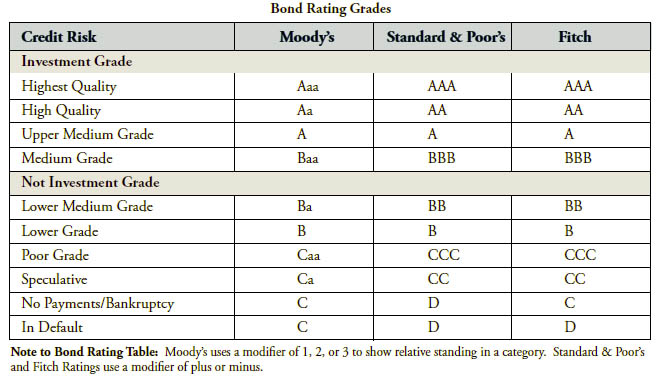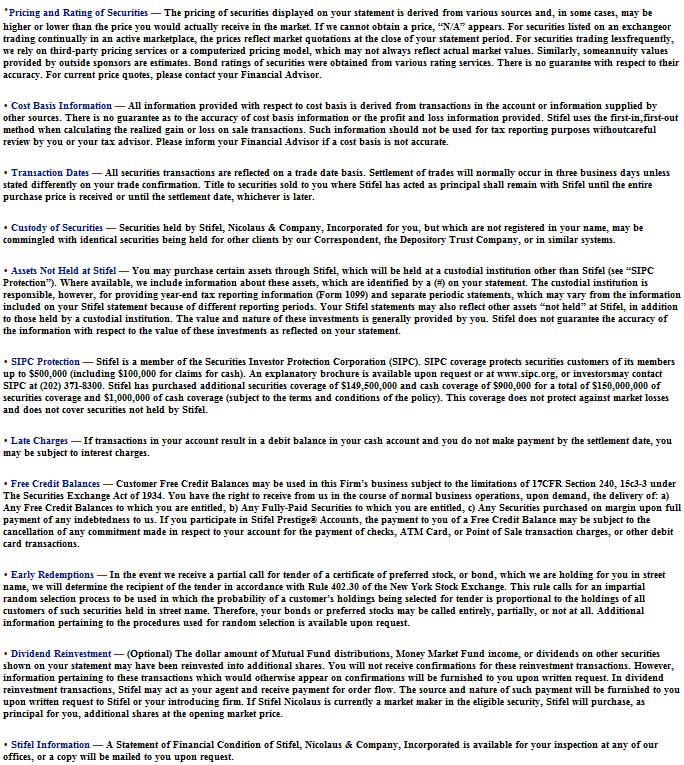|
ROLLOVER
CENTER |
| |
|
| |
STIFEL
NICOLAUS |
| |
|
|
Investment
StrategistTM
Should Municipal Bonds Be a Part of Your
Portfolio?
February 2009
|
Investing in the stock market over time has historically
proven to be the best place for investors to beat inflation.
However, recent market volatility has caused many investors to
seek out safer alternatives to stocks. Municipal bonds are
particularly popular these days, offering attractive yields in
addition to a predictable stream of tax-free income, generally
coupled with a high degree of stability with regard to payment
of interest and repayment of principal.
While municipal bonds can play an
integral role in a well-diversified portfolio, investors
should fully understand their characteristics before
investing. Municipal bonds are often deemed a �safe�
investment; however, investors need to be aware that bonds,
like all investments, do carry some risk, and those risks need
to be considered carefully.
|
 |
Municipal Bond Basics
Just as the federal government needs
funds to operate, local governments and public entities, such as
school districts, often issue municipal bonds to meet their financial
needs. Municipal bonds can be issued by states, cities, towns, or
public commissions to provide money for schools, hospitals, and other
public works. These securities provide income that is free of federal
and, in some cases, state and local taxes. Certain issues may be
subject to the alternative minimum tax. (Although income generated by
most municipal bonds is exempt from taxes, any capital gains earned
from the sale of bonds are subject to all federal and most state tax
laws.)
When an investor buys a municipal bond,
he or she is, in fact, loaning money for a certain period of time to
the issuer of the bond. In return for loaning funds, the investor
receives the principal amount back, with a specified amount of
interest (usually paid annually or semi-annually), at the time the
bond comes due or �matures.�
A bond�s face value, or the price at
issue, is known as its �par value,� and the interest payment is known
as its �coupon.� The price of bonds will fluctuate, similar to stocks,
throughout the trading day. However, with most municipal bonds, the
coupon payment will stay the same. If an investor purchases a
municipal bond in the secondary market at the face value, the bond is
considered to be sold at �par.� If a bond�s price is above its face
value, it is sold at a premium. If a bond�s price is below face value,
it is sold at a discount.
The two basic types of municipal
bonds are:
General Obligation Bonds
� Principal and interest are
secured by the full faith and credit of the issuer and usually
supported by either the issuer�s unlimited or limited taxing power.
General obligation bond issues are voter-approved.
Revenue Bonds
� Principal and interest are
secured by revenues from tolls, charges, or rents paid by users of the
facility built with the proceeds of the bond issue. Public projects
financed by revenue bonds include toll roads, bridges, airports, water
and sewage treatment facilities, hospitals, and housing for the
poor. Many of these bonds are issued by special authorities created
for the purpose.
|
V i s i o n
�
P l a n n
i n g
�
F o c u s |
|
SNINS010901 |
Should
Municipal Bonds Be Part of Your Portfolio?
|
|
|
|
Understanding Yields
As previously mentioned, the
coupon rate is the interest rate paid on a bond. This amount
is expressed as a percent of par value, $100.00 or $1,000
(municipal bonds are usually purchased in increments of
$5,000). For example, a 6% coupon would indicate that the
annual interest paid on a bond is $60. The current yield rate
indicates the current rate of return an investor will receive
on each dollar invested, without any adjustments for
differences between the purchase price and the maturity value.
The current yield rate is useful when comparing current yields
on various income-producing investments. The yield to maturity
rate indicates the overall rate an investor will earn,
including adjustments for any differences between the purchase
price and the maturity value. The yield to call rate indicates
the overall rate an investor will earn, including adjustments
for any differences between the purchase price and the call
price, in the event the bonds are called by the issuer. It is
important that investors make note of the yield to maturity
and yield to call on any bonds they are considering
purchasing.
|
 |
Bond Laddering
Investors can never be completely certain
as to where yields on municipal bonds are headed. A popular way for
investors to help balance risk and return in a bond portfolio is to
utilize a technique called laddering. To build a laddered portfolio,
investors purchase a collection of bonds with different maturities
spread out over their investment time frame. By staggering maturities,
investors may be able to reduce the impact that changes in interest
rates can have on their portfolio.
For example, an individual who wishes to
create a laddered portfolio could purchase bonds that mature each year
during a span of ten years. By using a rollover strategy as well, when
the first bond matures, the investor could reinvest those funds in a
bond that matures in ten years. As each bond matures, the investor
would continue this process. After ten years, the investor would own
all ten-year bonds, with one maturing every year. By laddering the
bond portfolio, an investor can worry less about fluctuations in
interest rates. If interest rates rise, the investor knows that he or
she will soon have money available from a maturing bond to take
advantage of a new bond. If interest rates should fall, then the
investor has at least managed to secure higher rates for a portion of
their portfolio. This strategy can also be used with certificates of
deposit (CDs).
The Effect of Taxes on an
Investment
Many investors find municipal bonds
attractive because of their tax advantages. However, it is important
for investors to compare tax-advantaged bonds to taxable investments
in order to determine the best investment for their situation.
In order to compare rates of return on
investments, it is helpful to adjust the tax-free rates to their
�taxable equivalent� rates. This is the taxable rate that would have
to be earned in order to net the same tax-free rate, after paying
federal income taxes. To calculate the taxable equivalent rate, simply
divide the tax-free rate by one minus your federal tax bracket rate.
For example: Assuming an investor�s
federal marginal tax bracket is 28% and an investment offers a
tax-free rate of 4%, the taxable equivalent rate would be 5.56%. (4%
/1-.28 = 5.56%)
Based on this calculation, the investor would have to
earn 5.56% on an investment that was subject to federal income
taxes to net the same 4% that the tax-free investment offered.

-
Should Municipal Bonds Be Part of Your Portfolio?
Knowing the Risks
While the income
generated by bonds is generally �fixed,� it is important to know that
the same is not true for a bond�s return. There are many risks that
may affect a bond�s return. These risks include:
Inflation risk
� Due
to the fact that most bond interest payments are fixed, their value
can be depleted by inflation. Therefore, the longer the term of the
bond, the greater the inflation risk.
Interest rate risk
� The
prices of bonds move in the opposite direction of interest rates. When
interest rates rise, prices of outstanding bonds fall. This is because
newer bonds will be issued paying higher coupons, which makes the
older, l ower-yielding bonds less attractive. On the other hand, when
interest rates fall, prices of outstanding bonds will rise.
Call risk
�
Many municipal bond issuers have the right to redeem or �call� their
bonds at a premium before they have matured.
Credit risk
�
Because a bond is a debt instrument, there is a risk that the bond
issuer will be unable to make its payments on time, or at all. To
assist in the evaluation of the creditworthiness of municipal bond
issuers, ratings agencies such as Moody�s, Standard & Poor�s, and
Fitch Ratings analyze bond issuers� ability to meet their debt
obligations and issue ratings accordingly. Municipal bonds have
historically been of high credit quality, due to the fact that state
and local governments have had much lower default rates than corporate
bond issuers.

|
Liquidity risk
�
Bonds, in general, do not offer the liquidity that stocks provide.
When purchasing a bond, investors need to remember that they
generally should be considered a longer-term investment.
Market risk
�
Because the rate on most municipal bonds is fixed, the market
value of these investments will fluctuate over time, reflecting
current changes in interest rates. Bonds follow the laws of supply
and demand. The more popular or less plentiful a bond, the higher
the price it can command in the market. Prices on bonds sold prior
to maturity may be higher or lower than the purchase price.
Diversify With Municipal
Bonds
Municipal bonds
can be important part of an asset allocation mix and can be useful
in diversifying your portfolio. Determining how much of your
portfolio should be allocated to bond investments will be based
upon your long-term financial goals and objectives, your tolerance
for risk, investment time horizon, and ability to invest. To learn
whether investing in municipal bonds is right for you, contact
your Financial Advisor today.

Account Disclosures
|
|
 Stifel, Nicolaus & Company, Incorporated
� Member SIPC and New York
Stock Exchange
� One
Financial Plaza, 501 North Broadway, St. Louis, Missouri 63102
� www.stifel.com
|
|
|
|




